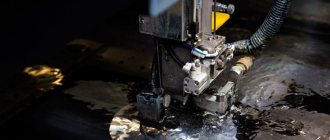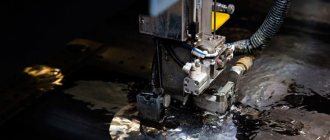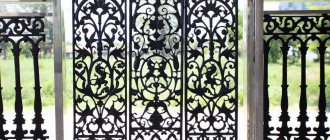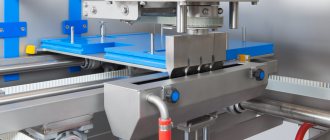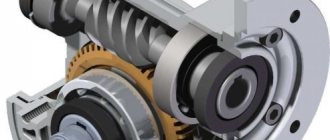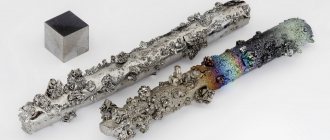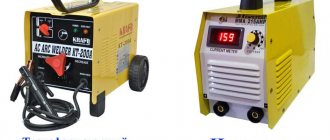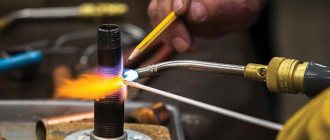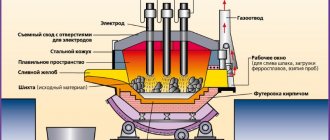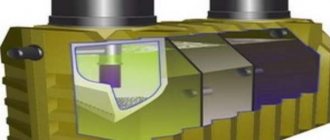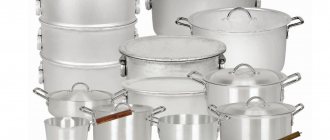Hi all. Some time ago I became the owner of a magnetic table. I’ve been wanting to try it for a long time, but upon the arrival of the package there wasn’t enough time to install it, and why should I, when the original glass coped with its functions perfectly. But I really wanted to leave the regular one for the simple reason that in the design of my table, a heating plate is tightly glued to the glass. And in order to remove the printed product from the table, you had to wait for it to cool completely, and then, using a spatula, scrape it off. This is not very convenient, especially if 3D printing is on stream. Not only is this inconvenient, it takes quite a lot of time.
In general, in this article I will share my experience and testing of the magnetic table. Let's discuss which plastics it works with and which it doesn't. And does its presence make life easier for us, as owners of 3D printers?
What is a flexible table? In my case, this is a heating plate to which glass is glued, onto which, in turn, a magnetic coating is already glued. The completion of this sandwich is the mat on which we will print. Please note that sets of a magnetic base and a mat without glass and a plate heater are offered on the Internet. In this case, all you need to do is stick the base to the glass and start using it.
Let's start by setting up the table. But the first thing we will do is dismantle the old one. For this operation we do not need any tool. We simply unscrew the nuts from the table legs and lift it up, pulling it out of the mounting holes. Turn the table over and unplug the plug. We take the new table and place it on the support structure. We connect the plug back. After this, we install the springs on the legs and tighten them with nuts to make it easier for ourselves to level the table. I recommend tightening the nuts to approximately the same distance.
Ready. Now you can start calibration. Let's first unscrew the adjusting screw as much as possible so that the nozzle does not rest against the soft surface of the table, since I assume that it can be damaged very easily. First, you need to set the home position of the extruder to approximately 0, and then proceed directly to alignment; when set to 0, the nozzle should be slightly pressed against the table.
Turn off the stepper motors and use a sheet of paper to level the table. The procedure is very simple - we move the extruder from one corner to another and make sure that in all corners the paper moves between the nozzle and the table with little force. Once the bed is relatively level, you can begin finer calibration during 3D printing. For the first start, it is best to choose a model with a large area of the first layer, during printing of which we will have time to set everything up. The setting principle is as follows. The extruded thread should lie slightly flattened and the width of the line in all corners of the table should be the same. If so, then your table is calibrated correctly.
Once we finish calibration, we move directly to testing. We will print from PLA, ABS and PETG. Of course, you can’t count on ABS, since the maximum recommended heating temperature for such magnetic tables for 3D printing is 80 degrees. Above this temperature, the table begins to lose its magnetic properties and the mat no longer adheres so well to the substrate.
Scope of application
Magnetic plates are used in metal processing on various types of machines.
First of all, these are grinding machines, where the use of a magnetic fixation method allows for maximum access to the processed surfaces and eliminates their mechanical damage. They are also used on milling and lathes, during welding operations, during assembly operations and in other cases. Magnetic plates are widely used due to their reliable fixation and relatively compact size. Another important advantage is maintaining installation accuracy throughout the entire life of the product. This type of equipment is rarely included in the basic configuration of the machine, and therefore they must be purchased and installed separately, taking into account the size, clamping force and other parameters of the product.
DIY magnetic table
Tools for grinding flat surfaces
When grinding, parts can be secured directly to the machine table using clamping bars. However, such fastening is used in cases where the parts cannot be fixed to a magnetic plate or other devices.
Pattern vices (Fig. 10.9a) differ from conventional machine ones in manufacturing precision and the ability to turn. The fixed jaw of the vice is integral with the base 1. The body has grooves for the passage of the movable jaw 2, which is moved by a screw 3. The base of the body has threaded holes for attaching the vice to various devices. All vise planes are machined at an angle of 90°. The pressed-in cylindrical measuring pin 4 is used to measure inclined planes.
Rice. 10.9. Pattern vice (a) and electromagnetic plate (b)
Electromagnetic plates . The design of the electromagnetic plate (Fig. 10.9b) is based on the following principle. If a wire is wound around an iron core (Fig. 10.10a) and a direct current is passed through it, the core will be magnetized. If you now bring a steel object to one of the ends of the core, it will be strongly attracted to the core. After the current in the winding stops, the magnetic action of the core will also stop.
You can bend such a core in the form of a horseshoe (Fig. 10.10b) and also pass current through its winding. In this case, the magnet will be even stronger. By combining horseshoe-shaped magnets into a group, we get an electromagnetic plate.
Rice. 10.10. Diagram of the magnetic action of current (a) and a horseshoe magnet (b)
The magnet poles located on the top of the plate are carefully insulated from its body with non-magnetic alloys (babbitt, zinc), due to which the magnetic forces are not dissipated in the body of the plate, but are directed directly into the body of the part. Only magnetic metals (for example, steel, iron, cast iron) can be attracted to the electromagnetic plate.
Electromagnetic plates are used in various sizes, round and rectangular. Only direct current is suitable for powering them, so machines are installed with devices that convert alternating current into direct current.
Electromagnetic plates provide reliable and quick fastening of the parts to be ground. To maintain the functionality of the plate, it is necessary to protect it from shocks and shocks, and also to ensure that no coolant gets on the windings. Upon completion of work, you should immediately wipe the working surface of the stove dry.
Magnetic plates
In addition to electromagnetic plates, magnetic plates with permanent magnets are used on grinding machines. This type of stove does not require special generators and rectifiers with wiring and distribution devices. However, as a rule, the force of their attraction is weaker than the force of attraction of electromagnetic plates.
The design of a rectangular magnetic plate and its operating principle are shown in Fig. 10.11. Its upper part is made of steel plates 1 with non-magnetic layers 2 between them (Fig. 10.11a). Strong permanent magnets 4 can be moved, closing them either to the iron plates or to the part being fixed. In Fig. 10.11b shows the position of the magnets when fastening parts 5, and in Fig. 10.11c – during their removal or installation. The magnets are switched using handle 3. The lower part of the plate 6 is fixed on the machine table.
Rice. 10.11. Magnetic plate:
a – general view; b – position of the magnets when securing the part; c - the same when installing and removing the part
Segmented grinding wheels for grinding flat surfaces
Surface grinding with solid grinding wheels of large diameter is economically unprofitable due to large waste, increased heat generation and the possibility of breakage during transportation. In addition, if a crack appears or partial destruction of the wheel, it is necessary to replace it entirely and lose a significant amount of usable abrasive material. These inconveniences are eliminated when using wheels made from inserted abrasive segments (Fig. 10.12). If one or more of them breaks, such segments can be easily replaced with new ones.
Magnetic tables. Coordinate tables
Table model
| KT120 | KT179 | KT180 | KT210 | |
| Working surface length | 400 | 500 | 700 | 730 |
| Working surface width | 120 | 180 | 180 | 210 |
| X-axis travel, mm | 220 | 287 | 480 | 480 |
| Movement along the Y axis, mm | 165 | 175 | 175 | 210 |
| Width of T-shaped grooves, mm | 10 | 12 | 12 | 14 |
| Maximum load, kg | 70 | 120 | 120 | 150 |
| Overall dimensions, mm | 483x430x250 | 840x510x330 | 955x485x140 | 1050x535x180 |
| Weight, kg | 22 | 32 | 49 | 84 |
| Availability | stock | order | stock | stock |
| Price, rub. | 40412 | 53097 | 65074 | 75573 |
Longitudinal feed - 80mm; cross feed - 50mm; table groove width - 10mm; distance between grooves - 35mm; the distance between the mounting holes is 115x100mm.
Longitudinal feed - 180mm; cross feed - 100mm; table groove width - 16mm; distance between grooves - 65mm; the distance between the mounting holes is 182mm.
Longitudinal feed - 180mm; table groove width - 16mm; distance between grooves - 65mm; distance between mounting holes - 182mm
Longitudinal feed - 220mm; cross feed - 160mm; table groove width - 10mm; distance between mounting holes - 200x160mm
Longitudinal feed - 225mm; cross feed - 150mm; table groove width - 12mm; distance between grooves - 72mm; distance between mounting holes - 250x240mm
Longitudinal feed - 270mm; cross feed - 120mm; table groove width - 14mm; distance between grooves - 62.5mm; the distance between the mounting holes is 170x152mm.
Longitudinal feed - 105mm; cross feed - 90mm; table groove width - 12mm; distance between grooves - 72mm; the distance between the mounting holes is 195mm.
| vendor code | Size | Working fields mm. | Price | Availability |
| P 87884 | 225x175x138 | 105×90 | 12 274 | in stock |
| P 97884 | 330x220x155 | 190×100 | 18 240 | in stock |
| P 08884 | 425x245x165 | 225x150 | 25 529 | in stock |
TO TOP[]
COORDINATORY ROTARY TABLE PK
Longitudinal feed - 400mm; cross feed - 150mm; table groove width - 12mm; distance between grooves - 72mm; distance between mounting holes - 250x250mm
CNC installation possible
| vendor code | Size | Workers field | Price | Availability |
| P 18884 | 600x240x150 | 400x150 | 31 243 | in stock |
TO TOP[]
MAGNETIC TABLE RM-300T
The PM-300T magnetic table is designed for securing workpieces made of materials during their processing on metal-cutting machines, metalworking and during control operations. Clamping occurs when the handle is turned 180° clockwise. The energy source is permanent ceramic magnets, which ensure constant clamping force throughout the entire service life. Processing of workpieces can be done with or without coolant.
Slab model
| PM-300T | |
| Nominal grip force | 80 N/s m³ |
| Overall dimensions, mm | 300x150x28 |
| Weight, kg | 11 |
| Availability | stock |
| vendor code | 25042004 |
| Price, rub. | 24 266 |
MAGNETIC TABLE RM-175
Slab model
| PM-175 | |
| Nominal grip force | 60 N/s m³ |
| Overall dimensions, mm | 175x100x60 |
| Weight, kg | 6 |
| Availability | stock |
| vendor code | 25042002 |
| Price, rub. | 14 066 |
TO TOP[]
MAGNETIC TABLE PM-300N
A magnetic table with an inclination (Sine magnetic plate) is designed for securing workpieces made of ferrimagnetic materials when processed on metal-cutting machines at various angles. The sine magnetic plate has wide versatility, since it has rotating parts in the longitudinal and transverse planes.
Slab model
| PM-300N | |
| Nominal grip force | 80 N/s m³ |
| Overall dimensions, mm | 300x150x120 |
| Tilt angle degrees | 0-45 |
| Weight, kg | 30 |
| Availability | stock |
| vendor code | 25042003 |
| Price, rub. | 42 147 |
TO TOP[]
MAGNETIC ROUND PLATE RM-160
Slab model
| PM-160 | PM-200 | |
| Nominal grip force | 90 N/s m³ | 90 N/cm³ |
| Overall dimensions, mm | Ø160 | Ø200 |
| ABIC Dimensions | 160x115x58x2.8 | 200x155x58x2.8 |
| Weight, kg | 8.4 | 14 |
| Availability | stock | stock |
| vendor code | P 44683 | P 54683 |
| Price, rub. | 11 066 | 18 010 |
TO TOP[]
PMS PLATE
Slab model
| PMS-100 | PMS-125 | |
| Nominal grip force | 90 N/s m³ | 90 N/cm³ |
| Overall dimensions, mm | 100×175 | 125×250 |
| Overall dimensions C-B-DE | 85x75x44 | 175x252x85 |
| Tilt angle .degree | 0-45 | 0-45 |
| Weight, kg | 11.5 | 21 |
| Availability | stock | stock |
| vendor code | P 74683 | P 94683 |
| Price, rub. | 19 529 | 21 500 |
Slab model
| PMS-150 | PMS-150-3 | |
| Nominal grip force | 90 N/s m³ | 90 N/cm³ |
| Overall dimensions, mm | 150×150 | 150×300 |
| Dimensions A-B-DE | 200x152x85 | 350x152x85 |
| Tilt angle .degree | 0-45 | 0-45 |
| Weight, kg | 14.8 | 28 |
| Availability | stock | stock |
| vendor code | P 84683 | P 05683 |
| Price, rub. | 22 824 | 28 700 |
TO TOP[]
MAGNETIC FLAT PLATE PMP
C=254mm D=20mm E=4.8mm(1+3.8) Handle in the form of a hex key. A plate based on permanent magnets has the following advantages compared to electromagnetic plates and hydraulic or pneumatic devices: - does not require connection to energy sources; — provides more accurate processing of workpieces; — ensures absolute clamping reliability; — maintains basic technical characteristics throughout the entire service life; - does not require repair and maintenance costs
Source: https://jnker.com/equipment/index_prisposoba_MillTool3-1.html
Main views and parameters
Depending on the method of fixation, there are two main types of plates - magnetic and electromagnetic. In the latter, the pressing force is created by two groups of coils that form an electromagnetic field. Magnetic ones are structurally similar to electromagnetic ones and also have two groups of magnets with different polarities. But the magnetic force acts constantly and in the non-working position it is prevented by blocks of non-magnetic material. After installing the part, the blocks are shifted and the part is fixed on the working surface.
The determining parameter is the overall dimensions of the slab. Not only the length and width of the workpiece, but also the height depend on it. It should be noted that the larger the size of the plate, the higher the weight and load on the machine’s work table.
Basic equipment parameters:
Making a surface grinding machine with your own hands
A surface grinding machine, which you can make yourself, is a very popular piece of equipment not only in manufacturing enterprises, but also in the home workshop. Such a device is practically indispensable in situations where it is necessary to grind and adjust metal parts. Of course, such work can be done manually, but this will take a lot of effort and time and will not allow achieving high precision processing.
Processing a workpiece on an industrial surface grinding machine
It makes sense to think about equipping your home workshop with a surface grinding machine if you often have to work on metal. In this case, you can choose one of two options: buy serial equipment or make such a machine yourself. The purchase of a serial machine is associated with serious financial costs, which is not always advisable for its use in a home workshop.
A homemade surface grinding machine will cost much less. Of course, the functionality of such equipment will be somewhat lower than that of serial equipment, but its capabilities will be quite sufficient to perform metal work at home.
Features of design and operation
The design of a magnetic plate is based on magnetic blocks and the product body. The blocks can be movable or stationary, which determines the possibility of changing the distance between the poles of the magnet. They consist of metal plates with ceramic magnets inside. The rest of the space is filled with material that does not have magnetic properties.
To move the magnetic blocks, a special eccentric mechanism is located inside the case. There is a handle to control the movement of the magnets. The stove control unit is located in the electrical cabinet. It adjusts the frequency to press the part. In addition, powerful cookers are also equipped with a demagnetization control unit, which sends reverse short-term pulses and removes residual magnetization. Otherwise, especially if a small part is being processed, after turning off the electromagnet it is very difficult to tear it off the surface.
Let us note the following features of the operation of electromagnetic plates:
Recommendations for making a surface grinding machine with your own hands
Serial surface grinding machines, in addition to their high cost, are also distinguished by their large dimensions. Not every workshop can accommodate such a machine, which also limits their use at home. That is why many craftsmen prefer equipment made by themselves.
Many structural elements for making a surface grinding machine can be found in your workshop or garage, but some of them will still have to be purchased additionally. These are materials and devices such as:
Working surface of the machine with a homemade clamping device
Do-it-yourself manufacturing of a surface grinding machine begins with a frame, the frame of which is assembled from corners, cut to the required sizes and connected by welding. To increase the ability of the bed to absorb vibrations that occur during operation of the machine, a sheet of chipboard can be mounted into its lower part.
The next structural piece of equipment that will need to be manufactured is the work table, which uses a 4mm sheet of steel welded to the top of the frame. Rail guides are fixed on the surface of the finished desktop, which must be highly durable and manufactured accurately. Such guides can be purchased ready-made or ordered from a qualified milling machine operator.
Magnetic plate for grinding machine
A carriage will move along the worktable guides, on which a magnetic plate or a special clamping device is placed. The carriage is also made by hand from corners, which are cut to the required sizes and connected by welding. Wheels and ball screw elements are fixed to the carriage using screw connections. A screw with a handle, which will be responsible for moving the carriage, is installed in bearing supports, fixed at both edges of the desktop. Finally, a magnetic plate or clamping device must be fixed to the carriage.
We print PETG plastic on a magnetic flexible table
Let's try printing using PETG plastic and see what happens. We run our test cube for 3D printing at a table temperature of 70 degrees and get a decent result.
The cube stuck to the table quite well, the corners were not bent. Basically, as expected, PETG will work great for this magnetic mat, as it is a low shrinkage material.
Now let's move on to the main question that most likely arose in your head - what about the reliability and wear resistance of such a table? You can answer as follows: it depends on how carefully you use it. I can only add that on the website of one European manufacturer of such sets of magnetic carpets and backings, the user is immediately asked to order a set of one backing and 5 rugs, and this is a reason to think about it.
Specifications.
2.1. The design of the rectangular magnetic plate uses permanent magnets placed in steel reinforcement, which is used as a magnetic energy concentrator.
Specific force of attraction – 80 N/cm2
Switching force – no more than 80 N
2.2. Technical characteristics of magnetic rectangular plates are given in the table
Table - Technical characteristics of rectangular magnetic plates
| Model | Width, mm | Plate length, mm | Base length, mm | Slab height, mm | Magnetic layer thickness, mm | Pitch of magnetic elements, mm | Weight, kg |
| Х41100-220 | 100 | 220 | 240 | 40 | 18 | 1+4 | 7 |
| X41150-400 | 150 | 400 | 420 | 40 | 18 | 1+4 | 19 |
Scope of application
Magnetic plates are used in metal processing on various types of machines. First of all, these are grinding machines, where the use of a magnetic fixation method allows for maximum access to the processed surfaces and eliminates their mechanical damage. They are also used on milling and lathes, during welding operations, during assembly operations and in other cases.
Magnetic plates are widely used due to their reliable fixation and relatively compact size. Another important advantage is maintaining installation accuracy throughout the entire life of the product. This type of equipment is rarely included in the basic configuration of the machine, and therefore they must be purchased and installed separately, taking into account the size, clamping force and other parameters of the product.
Device and principle of operation.
3.1. The plate consists of three main parts: movable and fixed magnetic blocks and a housing. Magnetic blocks are assembled from steel plates, between which ceramic permanent magnets are located. The free space between the steel plates is filled with non-magnetic material.
Rice. Magnetic plate device
3.2. When switched on, poles 2 of the power unit lie on non-magnetic elements 5 of housing 1, directing the entire magnetic flux of magnets 3 through adapter 4 and parts 6. when switched off, poles 2 are located under non-magnetic spacers of the adapter. As a result, the magnetic flux has a new direction.
3.3. The movable magnetic block is located inside the housing and can be moved using an eccentric wolf to the right or left by turning the handle 180˚. In the off position, magnetic circuits with different polarities are combined; there is no non-magnetic flux on the working surface.
Compared to electromagnetic plates and hydraulic or pneumatic devices, they have the following advantages:
Expert advice and price
The best-selling models of magnetic plates are:
- MP 400x125 sinus 2S7208-0003. Its advantage is the reliable clamping of workpieces using the magnetic currents of permanent magnets, which guarantees a constant clamping force throughout the entire operation. The price of such a device is from 50 thousand rubles.
- MP 250x100 (7208-0001) – slightly cheaper than the previous model, sold from 19 thousand rubles.
- MP flat X91 300x680 (66120-6) – makes it possible to process parts with a minimum thickness of 8 mm/7 mm. Its cost is from 170 thousand rubles.
It provides reliable fixation of the workpiece, which affects the quality of the work. Another good thing about this device is that the technical parameters and possibilities for using such a design remain the same over time. This quality arouses buyers’ interest in electromagnetic cookers.
How do surface grinding machines work?
The vast majority of parts made of metal undergo a technological operation such as grinding. To perform this with high efficiency and accuracy, surface grinding machines are used.
A rather difficult to manufacture banding machine with excellent functionality
Surface grinding machines of serial models can process both flat and profile parts. The surface processing accuracy that can be achieved using such devices is 0.16 microns. Of course, it is almost impossible to achieve such a result when processing on machines made by yourself. However, even the accuracy that homemade machines allow to obtain is quite sufficient for many metal products.
The load-bearing structural element of the machines of this group (as well as any other equipment) is the bed. Its dimensions directly determine what size parts can be processed on the machine. The most common material for manufacturing beds of surface grinding equipment is cast iron, since this metal, due to its characteristics, perfectly dampens vibrations, which is especially important for devices of this type.
Work table and controls of the 3G71M grinding machine
The structural element of surface grinding machines on which the workpiece is fixed is a work table having a round or rectangular shape. Its dimensions can vary significantly depending on the specific model of surface grinding equipment. The workpieces can be fixed on such a work table due to its magnetized surface or using special clamping elements. During processing, the work table makes reciprocating and circular movements.
We print with ABS plastic on a magnetic flexible table
I won’t even try to print with ABS plastic on a cold table. Let's set the maximum to 80 degrees and start the 3D printing process. The cube printed without coming off during printing. This is good, but I am sure that if you take a slightly larger part, the table will no longer be able to handle it.
For the experiment, let's take something larger. For example, our test block. As expected, during printing the block began to bend towards the center. Moreover, it was not the block that began to come off, but the magnetic mat, which began to rise at the corners of the block.
After finishing printing, I was very surprised when I realized that it was not the mat that lifted during 3D printing, but it seemed that the magnetic backing had come off the table.
Conclusion: I strictly do not recommend printing with ABS plastic on this magnetic table. I think that with similar materials with a high degree of shrinkage.
Let's move on to the last material on our list.
Operating procedure and maintenance.
4.1. Unpack the rectangular magnetic plate and read the product data sheet.
4.2. Place the magnetic plate on the machine table or workbench.
4.3. If necessary, the surface of the magnetic plate can be sanded in accordance with production requirements
4.4. After checking the correct fastening, you can proceed to working on the machine.
4.5. Place a workpiece made of ferromagnetic material on the plate in the required position and turn the lever 180 degrees. Check the secure fastening. After this, you can proceed to processing the workpiece.
4.6. The chips on the magnetic plate formed during processing of the workpiece can be removed with a sweeping brush after turning the handle 180 degrees, and then fix the workpiece back by turning the handle of the plate.
4.7. Upon completion of work, turn the handle and remove the workpiece from the magnetic plate.
4.8. Impact loading on a workpiece mounted on a magnetic plate is unacceptable, because this leads to a decrease in the magnetization of individual magnetic elements of the magnetic plate and, accordingly, to a decrease in the attractive forces of the plate as a whole.
4.9. If rough nicks appear on the working surface mirror of the magnetic plate and, as a result, the accuracy of the workpiece basing decreases, it is allowed to grind the working mirror of the magnetic plate.
4.10. The specific attractive force is checked with a test sample Ø 50 mm and height 20 mm at a distance of more than 40 mm from all edges of the surface of the working surface of the plate. Allowed in 10% of control points measured along the diagonal of the slab in 10 mm increments,
reducing the force of attraction by at least 1.0 kgf/cm2.
4.11. When polishing the mirror of the working surface of the slab, it is allowed to remove a total allowance of no more than 5.0 mm. In the delivery condition, the mirror of the working surface of the plate and the base are pre-polished. The tolerance for grinding according to TU 2-024-2773-82 is no more than 1.5 mm. Final grinding is carried out by the consumer on his own machine.
First test. PLA on a cold table.
As you can see, the cube came off the table quite easily. I will even say more - he moved away from the table too easily. It was as if he wasn’t holding on at all. Upon closer inspection, you can see that some corners are slightly bent. Not critical, but a fact.
Now let's set the table temperature to 70 degrees and see what happens. With these 3D printing settings, the part is much more difficult to remove from the table. And the corners are no longer bent.
Let's take a larger part to confirm the possibility of 3D printing PLA on a magnetic table.
Again no problems found. The bottom of the part turned out to be flat, with minor deformations. The corners are not bent.
Conclusion - printing PLA plastic on this magnetic table is definitely worth it.
Let's move on to the next material.
Structural solutions
The required arrangement of workpieces for the passage of the machine cutter is obtained due to the mobility of parts of the electromagnetic holding plate. The movement occurs in the transverse (0° - 30°) and longitudinal (0° - 45°) plane. The angle is set by the height of the set of gauge blocks, the specified values of which are summarized in the table.
The control is located on the easy-to-use side.
The electromagnetic holding plate consists of a body, poles, coils, base and terminal box.
The advantage of the current model is the small interpolar distance, which allows holding small parts (4 × 4 × 0.2 cm). The specific force of attraction can vary from 20 N/cm² to 130 N/cm².
The coils of the electromagnetic belt can be located motionless under the plate, which makes reciprocating movements on the grinding machine.
In table models that are independent from the electrical network, induction coils are replaced with magnetic blocks.
How does a magnetic block work?
Permanent magnets are installed in the body of the block for 2 strips. The distance between the poles of the table is indicated in the technical characteristics of the product. Rotating the control handle 180° through the eccentric brings the poles to the top edge of the plate. The part is captured by the field. The reverse action breaks the contacting metal parts, releasing the workpiece.
Electromagnetic sine cooker
According to GOST, the magnetic sine plate according to the type of control is performed:
Sine Plate Drawing
There are 5 accuracy classes of the device, in which the specific force of attraction of the table, according to GOST 16528-87, is equal to:
For all models, residual magnetism should not exceed 0.5 N/cm². The actual value is checked with a dynamometer connected to a control plate (steel 10, according to GOST 1050). Deviations are allowed by GOST in no more than 10% of the control points of the table.
Magnetic table for grinding machine
» Machine » Magnetic table for grinding machine
One of the main components of a grinding machine is a fixing element, with the help of which the workpiece is secured for further processing. Along with mechanical components, magnetic plates have become widespread, which differs from analogues not only in reliability, but also in good performance properties.
General information about the design
Mechanical magnetic plate
The main advantage of magnetic plates is their good workpiece fixation rate, as well as their relatively small size. To complete the machines, two types are used: electromagnetic and magnetic. They have significant design differences.
The stove has a fairly simple operating principle. A magnetic field is created on its surface, which holds metal-containing workpieces on the table surface. This allows you to process not only the outer plane of the materials, but also the end areas. In some cases, it is possible to grind several parts at the same time. Thanks to its magnetic properties, additional equipment or auxiliary devices can be installed on the work surface.
Design features of various types of magnetic plates:
- electromagnetic plate. It consists of a housing, inside of which there are two groups of electromagnetic coils. They are separated by a non-magnetic layer. When electricity is supplied to the installed part, an electromagnetic field is formed, which fixes the workpiece. The disadvantage of this design is the lack of clutch in the event of a power outage. Therefore, it is recommended to install a machine deactivation relay when such a situation occurs;
- magnetic plate. Structurally, it resembles an electromagnetic model. It also contains two groups of magnets that differ in polarity. Blocks of non-magnetic material are installed on the working surface of the stove. In their normal position, they prevent the emergence of a magnetic field. With the help of a mechanical device, they are shifted, as a result of which the workpiece is securely fixed on the table.
The mechanical magnetic plate has a high degree of reliability, but to turn it on/off you need to turn the lever. This affects the speed of changing the positions of parts, and as a result, productivity. Therefore, electromagnetic models are most often used for mass production, and mechanical ones for more precise processing.
In addition to horizontally oriented grinding plates, a device for cross-drilling rollers can be used. Magnets are located along the workpiece, which makes it possible to process cylindrical parts of complex shapes.
Technical specifications
Magnetic plates are rarely included as standard equipment in factory equipment. Most often they are purchased separately. Therefore, it is important to know their main technical characteristics, which must correspond to the parameters of a specific machine model.
The determining parameter is the dimensions. The size of the plate can vary from 10*25 cm to 32*100 cm. Moreover, as the dimensions of the device increase, its weight increases. This directly affects the maximum weight of the workpiece, since the plate is installed on a standard work table.
The main parameters that a magnetic plate should have:
- dimensions and weight. Not only width and length are taken into account, but also height. It may affect the maximum permissible part size;
- specific force of attraction. It must be uniform over the entire installation plane. Typically this parameter ranges from 50 to 120 N/cm²;
- distance between poles. This characteristic determines the minimum size of the workpiece.
During operation, the magnetic plate can change the geometry of the workpiece. Therefore, the process of installing and subsequently removing the part should be as careful as possible. You should also take into account the main disadvantage of electromagnetic models - heating of the surface during activation. This is not only the main reason for device failure, but also affects the properties of the workpiece.
The video shows an example of how a small magnetic plate works:
stanokgid.ru
Magnetic plates for grinding machines
Magnetic plates for grinding machines are a special class of metalworking equipment that is designed to hold steel workpieces on the working surface under the influence of electromagnetic attraction forces.
It would seem, why use such a sophisticated design when you can use traditional cams as a clamp, which reliably clamp the workpiece and provide maximum rigidity during processing? In fact, electromagnetic fixation using magnetic plates for grinding machines has a number of advantages, which we will discuss below.
The key advantage is the ability to operate the equipment in multi-threaded mode. The master can simultaneously fix several workpieces on one installation, thereby increasing the productivity of his work by an order of magnitude. In addition, the magnetic plate for the grinding machine can ensure extreme precision in machining the workpiece.
It is worth remembering that the plate is not capable of providing as much force as the locking cams. In addition, if an emergency interruption of the power supply occurs, the workpiece will fall off the working surface. That is why the scope of application of magnetic plates for grinding machines excludes work that requires high cutting forces.
Another disadvantage of such installations is the phenomenon of residual magnetism inherent in steel workpieces that were processed in this way. Fortunately, you can cope with the problem using a demagnetizer, which in most cases allows you to close your eyes to the above-described drawback.
Design and operating principle
The housing, the most important part of the design of the magnetic plate for the grinding machine, is made of mild steel. Its bottom has special pole protrusions. The working surface of the plate is covered with a special cover, sections of which are located above the poles and separated by special non-magnetic layers. Direct current is passed through the coils.
In this case, the outer surface of the table acts as one pole, and the remaining part of the surface represents the opposite pole. A metal part that covers the non-magnetic layer at any point on the slab closes the magnetic flux and is fixed on the surface.
The force of attraction is an important parameter to consider when working with a magnetic holding surface. It largely depends on the dimensions of the fixed structure and the material from which it is made. In addition, the force of attraction is influenced by the number of parts attached to the installation, as well as the design of the plate itself. Where the master placed the workpiece also affects this parameter.
The force of attraction is measured in N/cm2. The optimal parameter value is from 20 to 130 N/cm2.
Every craftsman should remember that the magnetic plate for a grinding machine heats up during operation. Frequent changes in the temperature of the structure can lead to the formation of condensation inside. Engineers involved in the design of such units carefully consider a system for protecting the coils from unwanted exposure to liquid. Bitumen, which is factory-poured into the internal cavity of the electromagnetic table, allows you to cope with this kind of task.
The magnetic block is an important part of the design. This movable element is moved by the operation of an eccentric top. The magnetic plate functions only when switched on. It will delight the craftsman with its operational capabilities and ensure the most even placement of the product on the working surface, which will immediately affect the accuracy of the final result.
Results
A magnetic plate for a grinding machine is capable of reliable fixation of the workpiece, which affects the quality of the task. It is interesting that the technical parameters and operational capabilities of this design do not change over time and as the service life of the equipment increases. This, in part, provokes increased interest in electromagnetic cookers from potential buyers.
As an additional advantage of the magnetic plate, it is worth noting that it does not require additional maintenance. If you follow the basic operating rules, it can last for decades without losing its functionality.
If you are looking for ways to increase productivity at your grinding machine, it’s time to think about purchasing an electromagnetic unit. Unlike standard jaws, this design allows you to process multiple parts at once with extreme precision and efficiency. All this is confirmed by the practice of tens of thousands of masters.
prostostanok.ru
Magnetic plates
Catalog
- 6Р12, 6Р13, 6Р80, 6Р82, 6Р83
- Gearboxes Automatic automatic transmissions
- Transmissions Automatic AKS
Magnetic plate
Magnetic plates are intended for use as the main element of equipment for cutting metal, for reliable fixation of ferromagnetic parts on machines for surface grinding or other production processes where reliable fastening and precise fixation of workpieces is required. According to its design, the magnetic plate can be divided into 3 basic units: - Housing: - Sliding block; — Fixing block (has the properties of ferromagnets).
By directly turning the handle all 180 degrees, direct movement occurs. Thus, all types of blocks can be moved freely in one plane.
The magnetic flux is eliminated on the surface during operation due to the direct combination of magnetic wires with different polarities in the shutdown state, when magnetic wires with the same polarity are combined, at this moment the flux is closed through the parts, which reliably fixes it.
Magnetic plates from the 7208 series have a number of advantages in comparison with hydraulic and pneumatic devices:
— Reliable fixation of the workpiece itself; — No connection required to a power source; — Minimum financial investments during operation and repair; — Technical properties are not lost during the service life. You can buy magnetic plates from our catalog at manufacturer prices. Large range of magnetic plates with delivery.
The product is in great demand, as it is a necessary item on certain machines during operation and is used for reliable metal processing. Among all the models, the most popular are rectangular magnetic plates, the price of which is not only affordable, but also available at a discount. Such plates reliably fix the workpiece. Magnetic plates are also widely used when cutting metal and drilling, during grinding (finishing and black).
stanki-osnastka.ru
Accessories for grinding machines. Magnetic plate. Plumbing |
Methods for installing workpieces on a surface grinding machine are very diverse and depend on the shape, size and material of the workpieces being processed, as well as on production volumes.
The most widely used are magnetic and electromagnetic plates.
These devices have a number of advantages: quick securing and release of workpieces; possibility of simultaneous fastening of several workpieces; the ability to attach other devices to the magnetic plate; good fit of the base surface of the workpiece to the surface of the magnetic plate; as well as the possibility of using stationary flat and round plates, angle plates, which are equipped with various magnetic blocks for fastening workpieces of complex shapes (for example, with protrusions).
However, this fastening method also has some disadvantages: the presence of residual magnetism, which requires demagnetization of the plate after processing; heating of electromagnetic plates during operation, reducing processing accuracy; the possibility of deformation of thin workpieces when pulled to the plate (after release, the workpiece returns to its original state); as well as the impossibility of fastening workpieces made of non-magnetic materials. To prevent heating of the plates during operation, combined plates with pulsed magnets are used.
Such a plate works as a permanent magnet with periodic activation of the electromagnet, which increases the force of attraction and eliminates heating.
Source: https://ooo-asteko.ru/magnitnyy-stol-dlya-shlifovalnogo-stanka/
